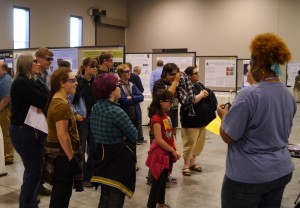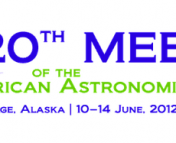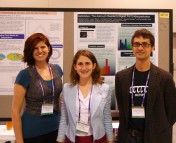Astrobites is again liveblogging AAS! In order to avoid inundating our readers’ RSS feeds, we’ll be updating this post with short paragraphs about the talks we’ve heard and posters we’ve seen. So keep checking back throughout Tuesday afternoon!
All day: Alaska Community Middle Schoolers visit the AAS, participate in hands-on science!
Today the exhibit hall/poster room was full of middle schoolers from the community that were invited to come to the meeting and learn about astronomy – firsthand, from astronomers. They attended a talk from former astronaut and Hubble repairman John Grunsfeld, then participated in hands-on scientific activities at the various booths. The kids seemed to really enjoy the experience, and AAS has suggested it will run more such outreach events at future meetings.
2:00 pm Press Release – Stars and Stellar Systems
Stars were the stars of this session, in which was announced an all-sky photometric catalog, a new age-rotation relation for M-dwarfs, and new studies using Eta Carina and its circumbinary environment as a laboratory for atomic spectroscopy. Arne Henden, director of the American Association of Variable Star Observers (AAVSO, which consists of both amateur and professional astronomers), presented the initial release of their multi-band all-sky catalog providing photometry to 3% precision (1-2% precision upon full completion) for ~42 million stars having visual magnitude 10 < V < 17. Many stars have never been accurately measured, and the resource will be publicly available. Scott Engle of Villanova next spoke about M-dwarfs, the lowest mass but most prevalent stars (about 75% of all main-sequence stars are M-dwarfs). M-dwarfs (unlike more massive stars) barely change in luminosity and temperature over their 10+ billion year lifetimes, making age determinations problematic. Engle’s team has used white dwarf/M-dwarf binary systems to calibrate the age-rotation relation (see these astrobites for more) for these stars as follows: since white dwarf cooling can be modeled, and the white dwarf’s mass gives its main sequence mass (and thus age), having the white dwarf in the system allows reasonably accurate age determinations for the binary system (and thus the M-dwarf, assuming coevolution). This allows ages to be estimated for all normal M-dwarfs with measured rotation periods, giving us crucial information about the most common stars (many of which host planets) in the Universe. Finally, Ted Gull (NASA Goddard) and Manuel Bautista (Western Michigan Univ.) discussed using the unusual object Eta Carina as an astrophysical laboratory. The system is a very high-mass (M_total > 110 M_sun, and L_total > 5 x 10^6 M_sun) binary that underwent an eruption about 150 years ago in which 10-40 M_sun of material was ejected. Due to the highly eccentric and tight orbit, the secondary star periodically disappears from view, allowing a change in the illumination of the erupted gas, and the study of rare atomic phenomena that are impossible to directly probe in the lab.
12:45: Straight Talk about an Astronomical Career: a Professional Development Session
This special lunch session aimed to provide advice on building mentoring connections was sponsored by the Committee on the Status of Minorities in Astrophysics (CSMA). The participants consisted of a large number of graduate students, but also many professors, postdocs, and research scientists that were no less than a fountain of good advice. The official panel consisted of a postdoc, a professor who just received tenure, and a scientist from the National Optical Astronomy Observatory (NOAO), and they shared their career trajectories with the audience. Some of the great pieces of wisdom that emerged from the session were:
- PhD astronomers have a very broad skill set, including programming (from coding), writing (journal papers), communication (teaching and talks), teamwork (from collaborations), and leadership (from leading projects), for example. These are all key qualities in high demand for many jobs, including those in industry, nonprofits, or consulting.
- As a graduate student getting ready to apply for postdocs, put a face to the name on your applications: contact colloquium organizers at institutions to which you are applying and ask if you can give a talk that year. Do this in the summer before you apply so that talk slots don’t fill up.
- When you’re applying for a postdoc, ask around and read as many applications from previous years that you can, and try to understand why those that were successful succeeded, and vice versa.
- In your application (for any job!), be (1) concise, and (2) clear about what you can do for the organization to which you’re applying, not telling them what they can do for you.
- Think about work-life balance. If family is a factor in your life, make it a factor in where you choose to apply (both geographically and otherwise).
- If you think you might eventually want to be at a primarily teaching institution, get teaching experience! If you don’t, get teaching experience anyway, you never know, you might like it a lot more than you expected to!
- Find mentors. LOTS of mentors, for every aspect you might need: scientific, personal, editorial, career-advice-oriented, etc.
- Be open to career possibilities you haven’t considered.
- Diversify your experience. Get practice writing proposals, reviewing papers, serving on committees, giving talks, being in collaborations, etc. Ask your advisor to include you in some of these aspects of the job!






Trackbacks/Pingbacks